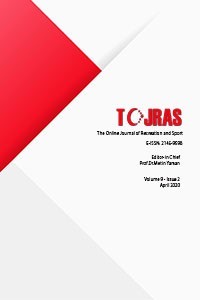EXAMINATION OF THE LEVEL OF PHYSICAL ACTIVITY IN TERMS OF SOME VARIABLES OF SPORTS SCIENCE FACULTY STUDENTS
EXAMINATION OF THE LEVEL OF PHYSICAL ACTIVITY IN TERMS OF SOME VARIABLES OF SPORTS SCIENCE FACULTY STUDENTS
The study was conducted in order to examine levels of physical activity in terms of some variables of sports science faculty students. This study covered 50 female and 52 male, 102 student in total with a mean age of 22.213.46, attending in faculty of sports science in university of Gazi. To the students who have attended the research study; height, body weight, body mass index, with the pedometer physical activity level measurements and questionnaire form of 10 questions generated by researchers have been applied. Physical activity level has been evaluated with the average of 1 week step numbers. SPSS 23.0 Statistical package was used for analyzing the data. Through the analysis of the data, percentage, frequency, T-test for independent samples, single factorial variance analysis ANOVA , Tukey HSD test, and correlation analysis have been used. According to the findings of the research study; when BMI of students of Faculty of Sports Sciences it can be seen that 86.3% of them have good fitness, 9.8% of them have over weight and 3.9% of them are in obesity level. When physical activity levels are reviewed majority of the students 47.1% have sedantery lifestyle, following this on the second row 23.5% of them are low active individuals and as the least 15.7% are active and highly active individuals. As a consequence, while Faculty of Sports Sciences students have generally sedantery lifestyle they are at good fitness levels, as long as Daily usage periods of computer increases weekly stepm numbers decrease thus physical activity levels are influenced in a bad way, and as long as ages increase or sleeping periods decrease television watching periods decrease, and as long as computer usage period increase body mass index is influenced badly and the women step numbers are lower compared to men thus physical activity levels are lower
Keywords:
Physical Activity, Body Mass Index, Sport, Student,
___
- Alevizos A, Lentzas J, Kokkoris S, Mariolis A, Korantzopoulos P.(2005). Physical activity and stroke risk. Int J Clin Pract. 59(8):922-930
- Baltaci G 2008. Cocuk ve spor. Ankara: Klasmat.
- Bravata, D. M., Smith-Spangler, C., Sundaram, V., Gienger, A. L., Lin, N., Lewis, R., ... & Sirard, J. R. (2007). Using pedometers to increase physical activity and improve health: a systematic review. Jama, 298(19), 2296-2304.
- Caspersen C. J., Powell K. E., Christenson G. M. (1985). Physical activity, exercise and physical fitness: definitions and distinctions for health-related research. Public Health Rep. 100 126–131.
- Corbin, C. B., Lindsey, R., Welk, G., & Corbin, W. R. (2000). Concepts of fitness and wellness: A comprehensive lifestyle approach. Boston: McGraw-Hill.
- Haase, A., Steptoe, A., Sallis, J. F., & Wardle, J. (2004). Leisure-time physical activity in university students from 23 countries: associations with health beliefs, risk awareness, and national economic development. Preventive medicine, 39(1), 182-190.
- Peker I, Ciloglu F, Buruk S, Bulca Z 2000. Egzersiz biyokimyasi ve obesite. Istanbul: Nobel Tip Kitabevleri Ltd.
- Saygin O 2012. Cocuklarin fiziksel aktivite duzeyleri ve vucut kompozisyonlarinin belirlenmesi, M.U. Yayinlari Mugla.
- Tudor-Locke CY, Hatano RP, Pangrazi M 2008. Revisiting “how many steps are enough?” Med Sci Sports Exerc, 40(7 Suppl): S537-S543.
- Tudor-Locke C, Bassett DR Jr. How many steps/day are enough? preliminary pedometer indices for public health. Sports Med. 2004;34(1):1-8
- Zorba E, Saygin O 2013. Fiziksel aktivite ve fiziksel uygunluk. Ankara: Firat Matbaacilik.
- Zorba E., Saygın Ö.(2009)Fiziksel Aktivite ve Fiziksel Uygunluk, Bedray Yayınları, İstanbul, Ekim.
- ISSN: 2146-9598
- Yayın Aralığı: Yılda 4 Sayı
- Başlangıç: 2012
- Yayıncı: METİN YAMAN
